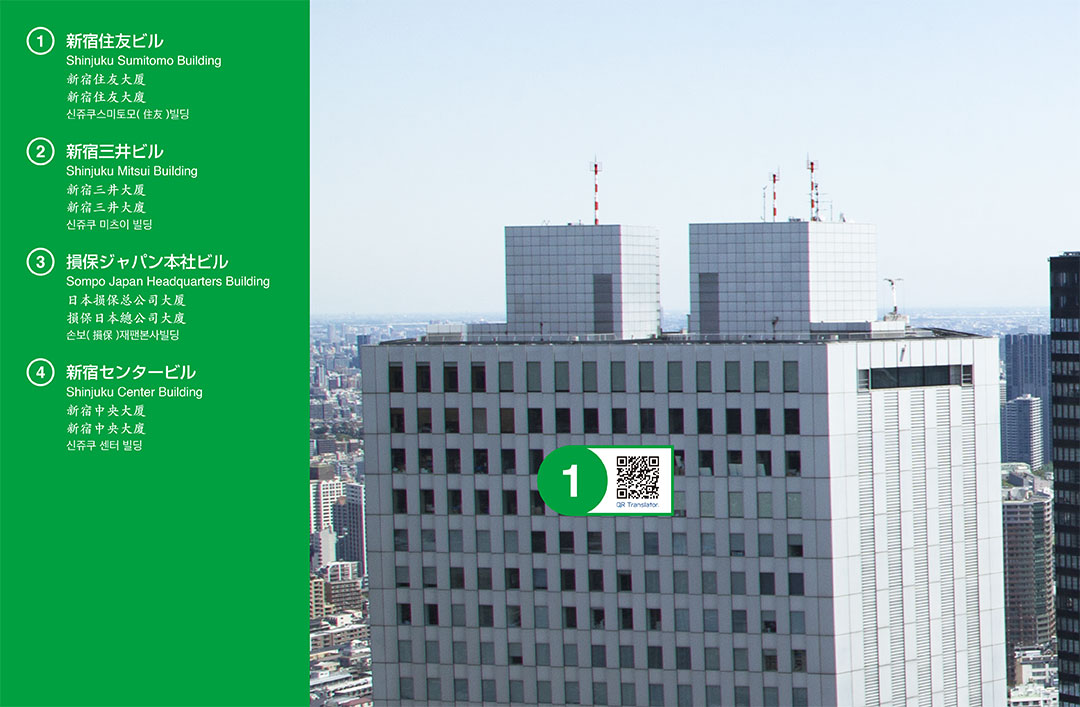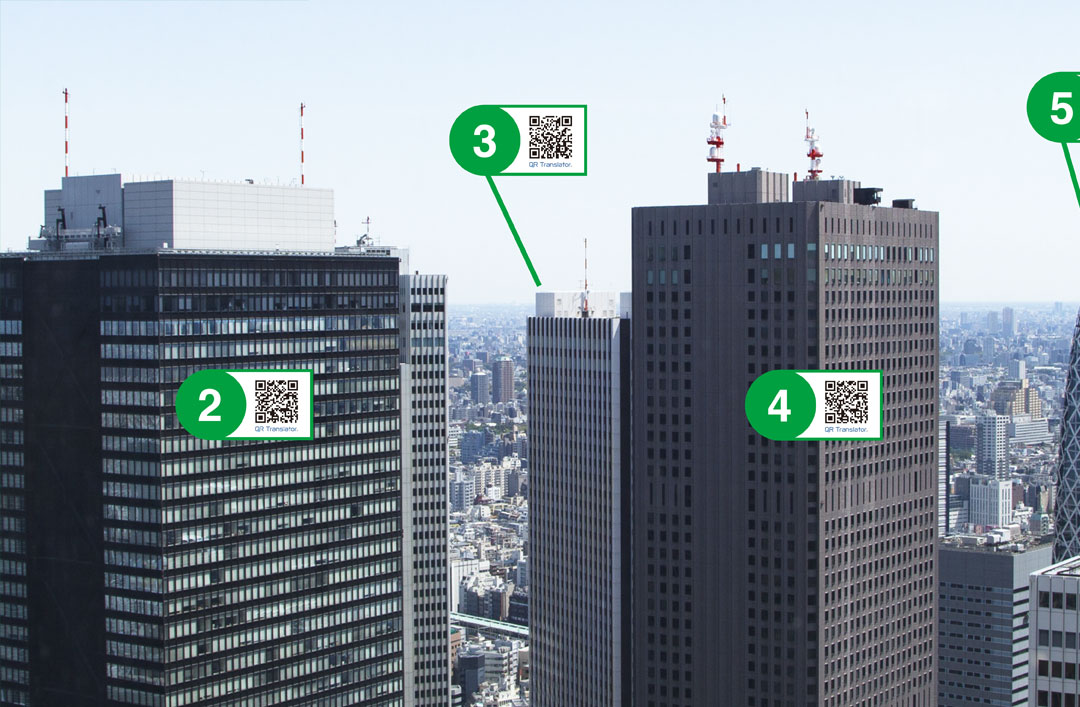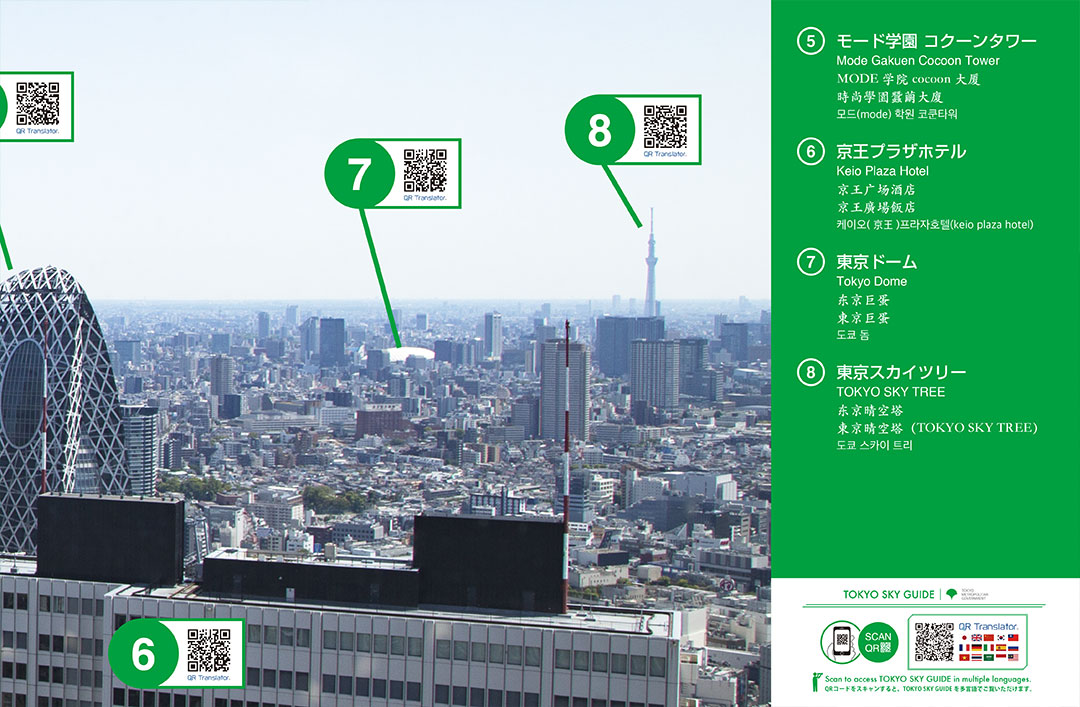North-East direction
1 Shinjuku Sumitomo Building

Introduction
Known by its nickname “Triangle Building,“ this high-rise building has many restaurants and bars on the upper floors. It is 210-meter high with 4-story basement and 52 floors above ground.
Route
It is an 8-minute walk from the west exit of JR Shinjuku station, or right next to A6 exit of Tochomae station on subway Oedo line.
About the building
Completed in 1974, it was a pioneer of skyscrapers in Shinjuku; Japan’s first building which exceeded 200 meters in height. It is also known for having a triangular open ceiling in its center.
Tokyo Metropolitan Government Buildings seen from Shinjuku Sumitomo Building
Popularly known as the Sankaku (triangle) Building, the Shinjuku Sumitomo Building was completed in 1974. It is one of long-established high-rise buildings in Nishi Shinjuku. Looking south-west, the Tokyo Metropolitan Government building is right in front of you. Enjoy its overwhelming view. In the evenings, look to the west, and you will see a beautiful night view of the Shibuya, Suginami, and Nakano areas. During the daytime, when the weather is clear, you can see the mighty Mt. Fuji.
2 Shinjuku Mitsui Building

Introduction
This glass building based on black is one of the oldest high-rise buildings in Shinjuku. With 3-story basement and 55 stories above ground, it is 225 meters high.
Route
It is an 8-minute walk from the west exit of JR Shinjuku station.
About the building
Completed in October 1974, it became the tallest building in Japan, surpassing the previous record holder, the adjacent Sumitomo Building which was completed in March 1974.
3 Sompo Japan Headquarters Building

Introduction
This building has white exterior walls and a brown line on each narrower side. Its shape is widening toward the bottom. It has 6-story basement and 43 stories above ground and is 200-meter high.
Route
It is a 5-minute walk from the west exit of JR Shinjuku station.
About the building
The site features an art gallery that could be called the beginning of corporate support of the arts in Japan. It houses van Gogh's “Sunflowers.“
Architects
Many professors from The University of Tokyo, including Yoshikazu Uchida who is well known for building Yasuda auditorium in the University of Tokyo, participated.
4 Shinjuku Center Building

Introduction
Shinjuku Center Building is a sedate building with brown exterior walls. It has 4-story basement and 54 stories above ground and is 223-meter high.
Route
It is a 5-minute walk from the west exit of JR Shinjuku station.
About the tower
When completed, it was the tallest building in Japan; currently being a part of the skyscrapers in Shinjuku. There are several medical clinics on the 4th and 5th floors. The 1st basement floor has an open space and is connected to the Shinjuku underground shopping center. People also can go to Nomura building via the underground shopping center.
5 Mode Gakuen Cocoon Tower

Introduction
This is a 203-meter high building with 3-story basement and 50 stories above ground. Its extraordinary exterior makes the tower stand out even among the many high-rise buildings in Shinjuku. Mode Gakuen education group manages the building. Tenants include three vocational schools; Tokyo Mode Gakuen, HAL Tokyo, and Capitol Medical School. The largest "Book1st" shop in Tokyo area is also a tenant.
Route
It is a 3-minute walk from JR Shinjuku station.
About the tower
Its characteristic is the very unique cocoon-shaped exterior which is put the meaning of “Embrace and touch off the young creators.“
Architects
Kenzo Tange Associates
6 Keio Plaza Hotel

Introduction
Keio Plaza Hotel is the first high-rise hotel in Japan, consisting of the main and south wings. It is the hotel section of Keio group with branches in Hachioji and Sapporo cities.
Route
Located across street from Tokyo Metropolitan Assembly Building, it is only a few-minute walk from Tokyo Metropolitan Government Building as well.
About the hotel
The main wing opened in 1971, and the south wing was added in 1980; having 1,440 guest rooms in total. It was introduced in Michelin Guide Tokyo as "a very comfortable hotel."
Architects
Nikken Sekkei Ltd.
7 Tokyo Dome

Introduction
This is a dome-shaped baseball stadium located in Korakuen, Bunkyo-ku. "Big Egg" is its nickname for its white-colored air dome.
Route
It is a 5-minute walk from JR Suidobashi station, or a 2-minute walk from Metro Korakuen station.
About the dome
It is the first roof-top-covered baseball stadium in Japan and is the home ground of the Yomiuri Giants baseball team. In addition, it is also used for multipurpose events such as American football and music concerts. Because it is the first air-dome architecture in Japan, the construction faced a lot of difficulties.
Architects
Tokyo Dome was built by Nikken Sekkei and Takenaka Corporation.
8 TOKYO SKY TREE

Introduction
Tokyo Sky Tree is opened on May 22, 2012. Tokyo Sky Tree is a 634-meter-high new landmark in Tokyo. It is the world's tallest free-standing steel tower with two observatories at 350 meters (1148 feet) and 450 meters (1476 feet) above ground. Moreover, a group of commercial facilities, called the "Tokyo Sky Tree Town," encircles the base of the tower.
Route
Get off at Tokyo Sky Tree Station on the Tobu Isesaki Line.
About the Building
The tower is required to have a height of 600 meters or more to transmit radio waves throughout the Kanto region as a new broadcasting tower. It will replace the Tokyo Tower that has started to experience difficulties in playing its role as a radio wave transmission tower because it has become surrounded by high rise buildings. The Tokyo Sky Tree has been built, using state-of-the-art construction techniques, to ensure that it will survive the harsh natural environment in Japan. The tower was unharmed by the Great East Japan Earthquake that occurred while it was still under construction.
Architects
Nikken Sekkei Ltd. is in charge of the design and supervision and Obayashi Corporation is in charge of the construction. Mr. Kiichi Sumikawa, a sculptor and the former President of the Tokyo University of the Arts, is involved in the design supervision.



